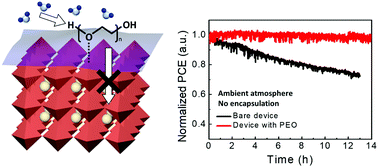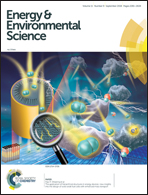Enhanced solar cell stability by hygroscopic polymer passivation of metal halide perovskite thin film†
Abstract
Long-term device stability is one of the most critical issues that impede perovskite solar cell commercialization. Here we show that a thin layer of a functional hygroscopic polymer, poly(ethylene oxide), PEO, on top of the perovskite thin film, can make perovskite-based solar cells highly stable during operation and in a humid atmosphere. We prove that PEO chemically interacts with lead ions on the perovskite surface, and thus passivates undercoordinated defect sites. Importantly, defect healing by PEO not only results in an improvement of the photo-voltage but also makes the perovskite thin film stable. We demonstrate that the hygroscopic PEO thin film can prevent water inclusion into the perovskite film by screening water molecules, thus having a multi-functional role. Overall, such interface engineering leads to highly durable perovskite solar cells, which, in the presence of PEO passivation, retained more than 95% of their initial power conversion efficiency over 15 h illumination, under load, in ambient atmosphere without encapsulation. Our findings experimentally reveal the role of interface engineering in mastering the instability of perovskite materials and propose a general approach for improving the reliability of perovskite-based optoelectronic devices.



 Please wait while we load your content...
Please wait while we load your content...